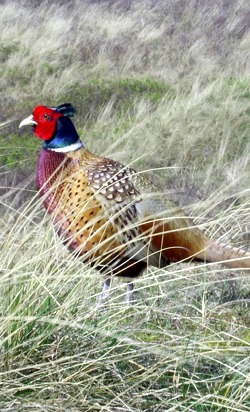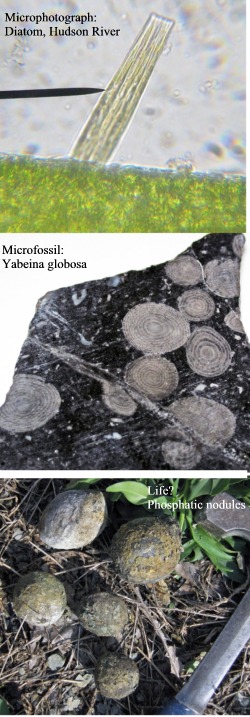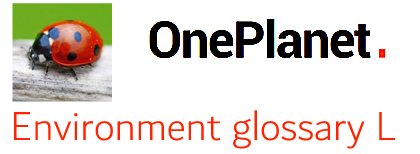OnePlanet is for people who speak English as a second or third language
A B C D E F G H I J K L M N O P Q R S T U V W X Y Z CLICK for list of all the words
L is for: |
: |
lead shotShotguns, the guns that are used for the sport of shooting birds and small mammals such as rabbits, fire lead shot. This is, quite literally, lead (Pb, the toxic heavy metal). These sports put thousands of tons of lead into the environment every year. A lot of shooting is done on farmland and in private woodland, and "wildfowling" (shooting wild ducks and geese) is done in wetland areas. In the case of wildfowling, this is exactly the place where birds are likely to swallow lead shot while feeding, and get lead poisoning. In Europe as a whole, the European Chemicals Agency estimates that 18,000 - 21,000 tonnes of lead shot is fired each year by sportsmen. Many birds swallow small stones and grit (very small stones) because it helps them process their food. Wetland birds often swallow lead shot by accident. A November 2015 report by the University of Oxford says that this kills 50,000 - 100,000 wetland birds in Britain every winter. It is difficult to be more accurate, because some birds swallow lead shot and die later that year, perhaps over the sea while migrating, or after migrating to Greenland or Siberia; plus there are wetland birds that suffer health problems but do not die until two years later; plus there is failure to reproduce; plus there are birds of prey that eat the dead and dying birds. The figure for the whole of Europe is equally approximate. The ECA's best estimate is that 400,000-1,500,000 birds die from lead poisoning in Europe each year. Lead does not go away; it persists in the environment and may poison water supplies for local people. It also bioaccumulates, which means that apex predators (animals which eat a lot of other animals) get more lead. Lead has been removed from vehicle fuel in Britain, so pheasant shooting and wildfowling are the main source of unregulated environmental lead contamination in Britain. Between 6 and 7 million shotgun cartridges are sold in Europe every year, at a cost of about £180-£420 per thousand. That means a market of about £1,500,000 a year. The cartridge industry now offers "non-toxic" cartridges with bismuth shot (Bi). These are much more expensive, costing about £1120-£1800 per thousand. Many sportsmen have strongly resisted attempts to make them use non-lead shot, because they consider it an attack on their freedom. In any case, bismuth also bioaccumulates and it is also toxic (it causes kidney damage). Very little is known about the effect of bismuth shot on freshwater or marine environments because it has not been used as much as lead shot. A YouGov survey in 2018 found that 69% of people in Britain think that shooting birds for sport should be illegal. |
 |
lifeLife ... what is it? We don't know. We really don't. We know that life often (but not always) has some connection with electricity. We can't create life, we can't measure it, and we can't detect it unless it does something obvious such as running away when it sees us, or making non-crystalline patterns in rock. There is no Star Trek technology to "scan for life forms". Even when a human is lying on a table in hospital, surrounded by the latest medical equipment, the doctors often can't tell whether that person is dead or not. We don't even have a scientific definition for life. Life, it seems, is like art; you know it when you see it ... maybe. Every kind of life we have found is "organic", in other words it's based on carbon. It usually needs oxygen, and it's either green or runs around quite quickly and dies after a few years. However it's quite possible that there is life on other planets that is based on silicon, germanium or other elements. What kind of life would fly in the hydrogen/helium atmosphere of Jupiter, or swim in the methane seas of Titan? It's even possible that there is silicon-based life on our own planet. If it's very slow, we wouldn't necessarily recognise it as life. Can there be life without oxygen? Certainly. In fact, there was very little oxygen in the Earth's atmosphere until tiny organisms living in the ocean first discovered how to make sugar from sunlight by photosynthesis. They produced oxygen as a waste product. As a hazardous waste product, in fact. Although oxygen is what keeps us alive, it also causes damage to our tissues and it was fatal to many kinds of life that lived before the Great Oxidation Event (GOE). That's why the GOE is also called the Oxygen Catastrophe or the Oxygen Crisis. Even today there are complex life-forms that can only survive where there is no oxygen, for example the Loricifera that were found in 2009 at the bottom of the L'Atalante basin in the Mediterranean. Can there be life under 10,000 metres of sea water? Certainly, in the Marianas Trench. Can there be life under 1,000 metres of sea water and 2,400 metres of rock? Yes, the IODP (International Ocean Discovery Program) found some in 2012. Can there be life that lives in ice? That's easy - there are lots of ice worms (Mesenchytraeus annelid worms) that live their whole lives in glacier ice; and there's the Antarctic sea anemone Edwardsiella andrillae that likes to live on ice surfaces underwater. Some life loves to eat arsenic; and one (Thermococcus onnurineus) is happy in temperatures up to 90 degrees centigrade. It lives without sunlight, by hydrothermal vents at the bottom of the sea, using just the energy produced when methanoate (formate) from the vents is converted into bicarbonate and hydrogen. Some very common life forms do things that ought to be impossible. Yeast is a micro-organism that can be used to make bread, cakes and alcohol. Scientists have found beer yeast that's still somehow "alive" after 5000 years in an old pot in an Egyptian pyramid. Just add water and you can use it to make ancient Egyptian beer. Or think about tardigrades ("water bears", which are microscopic animals). You can freeze a tardigrade to lower temperatures than exist naturally on Planet Earth; you can dry it out, boil it, put it in vacuum, expose it to hard radiation, and it will usually come back to life. Was it alive the whole time? Was the yeast alive the whole time? "Yes! ... er, no? ... well, probably ... OK, we have no idea! Are you happy now?" Scientists have not been able to make life in the laboratory. They have tried, but all they can do at present is change life, by selective breeding or by genetic manipulation. If we do create a new life form, we don't know what it will do. It could be (a) quite interesting if you're a scientist (b) extremely dangerous or catastrophic for life on Earth. A new form of life will have completely unknown abilities; this is mad scientist stuff. See Hubris. It's nature, not science, technology or industry, that provides us with everything we eat, drink and breathe, and regulates the temperature of the planet so we don't boil or freeze. "Is it life?" images: Microphotograph of diatom by Roban Kramer, Creative Commons BY-SA 2.0 Microfossil of Yabeina globosa by James St John, Creative Commons BY 2.0 Phosphatic nodules, also by James St John. |
 |
...New words every week; CLICK HERE for a full list |
 |
* |
* |
A B C D E F G H I J K L M N O P Q R S T U V W X Y Z CLICK for list of all the words
